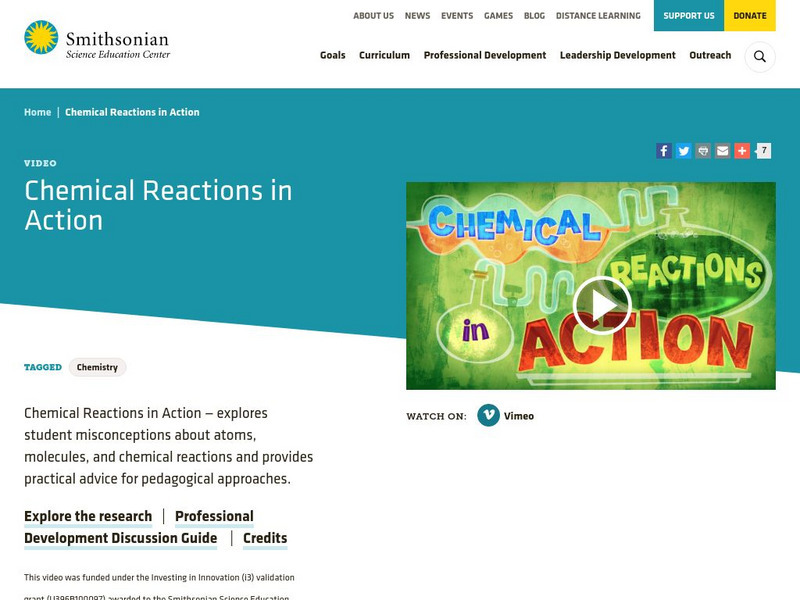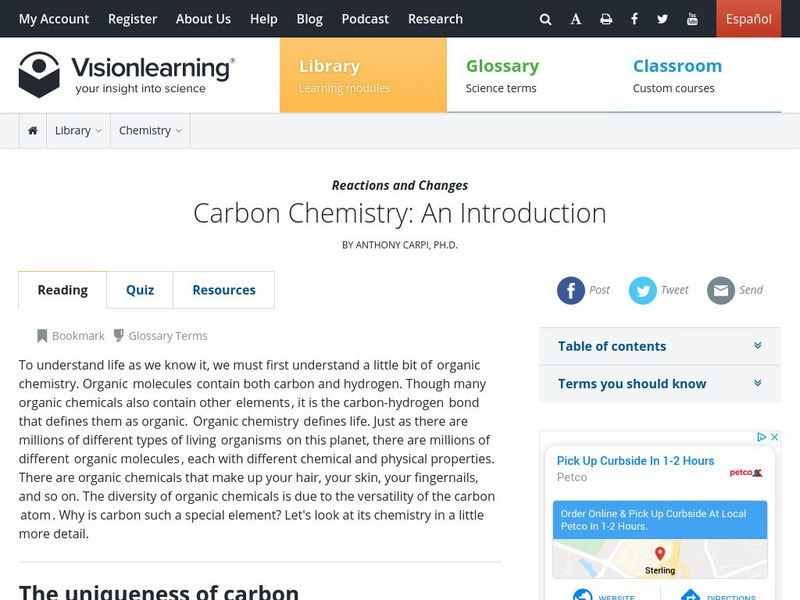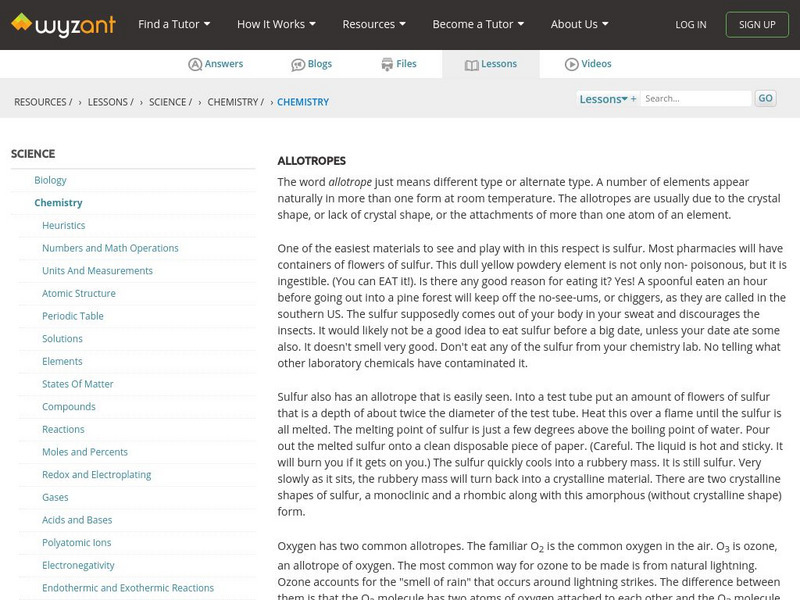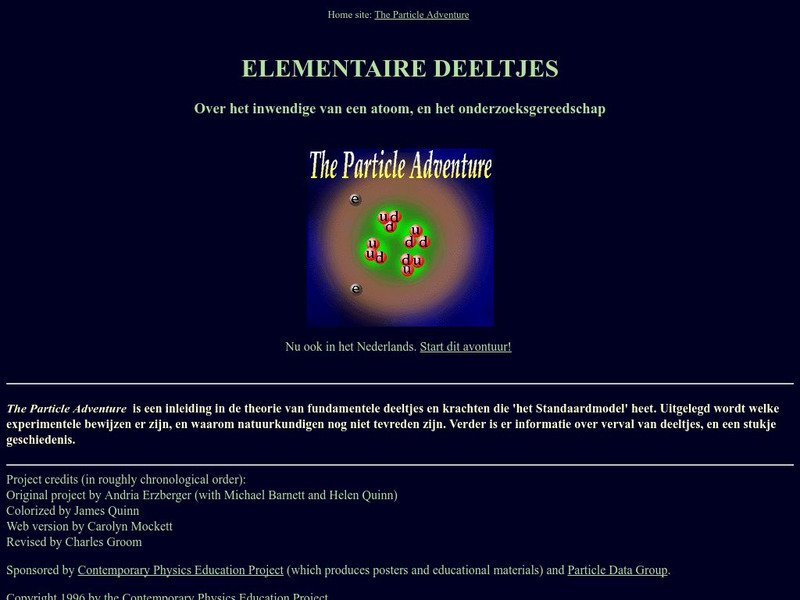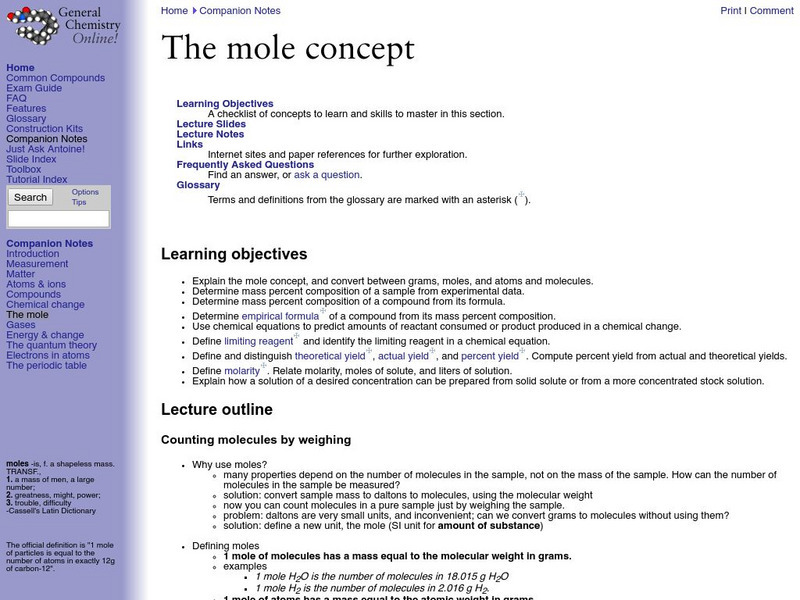Famous Scientists
Famous Scientists: Jane Marcet
Learn about the life and scientific accomplishments of Jane Marcet in this article.
Smithsonian Institution
Smithsonian Science Education Center: Chemical Reactions in Action
This video is a professional development resource that explores student misconceptions about atoms, molecules, and chemical reactions. It also gives some pedagogical approaches for approaching these subjects. [10:12]
Vision Learning
Visionlearning: Carbon Chemistry: An Introduction
A nice introduction to why carbon is the key to organic chemistry. Explains the role of valence electrons in the bonding of carbon and gives lots of "stick figures" models of simple hydrocarbons.
CK-12 Foundation
Ck 12: Chemistry: Areas of Chemistry
[Free Registration/Login may be required to access all resource tools.] Introduces the major areas and disciplines of chemistry.
CK-12 Foundation
Ck 12: Chemistry: Pure and Applied Chemistry
[Free Registration/Login may be required to access all resource tools.] Describes comparisons of pure and applied chemistry approaches to chemistry research.
Wyzant
Wyzant: Chemistry: Terms
This lesson provides a list of chemical terms, defines them, and uses examples to describe and explain each. These include allotropes, ionic compounds, methane, carbon dioxide, alkali flats, blue vitriol, and others.
Chem Tutor
Chem Tutor: Chemistry: The Octet Rule as Seen on the Periodic Chart
Describes the Octet Rule as it pertains to the Groups 1-7 on the Periodic Table of Elements. It also provides a Sideways Periodic Chart With Electron Shell Numbers.
Other
Sacnas: The Biography Project
This site profiles dozens of Chicano/Latino and Native American scientists. Most are still active in their field of research. Searchable by field of science. Also contains links to some fantastic science sites by topic.
Chem4kids
Chem4 Kids: Periodic Table and the Elements
Students can use this resource to interact with the periodic table. Information is available for each element. This is a good source of information for younger students.
National Inventors Hall of Fame
National Inventors Hall of Fame: Alfred Nobel
This site honors Alfred Nobel for his invention of dynamite. Content includes a very brief biography and a focus on the impact of dynamite on our culture.
National Inventors Hall of Fame
National Inventors Hall of Fame: Roy J. Plunkett
This website provides biographical information about Roy J. Plunkett and his discovery of Teflon.
CK-12 Foundation
Ck 12: Chemistry: Defining Chemistry
[Free Registration/Login may be required to access all resource tools.] Describes a definition of chemistry and a consideration of both macroscopic and microscopic phenomena.
Other
Science: Profile: Sid Altman
Sid Altman is a Nobel Prize winning chemist. He won the award in 1989 for his discovery of catalytic RNA. Read some interesting facts about his life and accomplishments.
Sophia Learning
Sophia: Converting From Mass to Particles Using a Balanced Chemical Equation
A narrated screencast explaining how to use a balanced chemical equation to determine the number of particles of a substance given the starting mass of another substance. [4:46]
Other
Stephen Lower: Chemistry Websites
Stephen Lower is a retired chemistry professor from Simon Fraser University who unceasingly continues work in the world of chemistry. Lower provides websites that will enhance chemistry and pseudoscience lessons for both educators and...
Amethyst Galleries
Fluorite, "The Most Colorful Mineral in the World"
This resource provides information about Fluorite.
Other
Particle Adventure Dutch Version
Dutch version of the well-known "Particle Adventure" physics website that teaches students about atoms, mass, particle physics, and quantum physics. The site discusses theories related to physics and provides other links related to the...
Arizona State University
Arizona State University: What Is Photosynthesis?
This site provides links to many good sites covering the complex concept of photosynthesis.
Frostburg State University
General Chemistry Online: Faq the Mole Concept
This FAQ site over general chemistry concepts presents the question: "Why are moles used?" It explains what moles are and how they can be used to count molecules and how grams can be turned into moles.
Open Curriculum
Open Curriculum: Balancing Redox Reactions in Acidic and Basic Solutions
This article introduces techniques to balance redox reactions that are in acidic or basic solutions.
Science Buddies
Science Buddies: Project Ideas: Crime Scene Chemistry: The Light of Luminol
Experiment with the chemical called luminol, which emits a blue light when it reacts with other chemicals. This science fair project explores whether temperature affects the amount of light emitted. The Science Buddies project ideas are...
Oswego City School District
Regents Exam Prep Center: Moles & Stoichiometry: Moles Resource
A nice page of links to follow for learning about moles. Contains links to sites that have explanations of moles and molar mass, practice problems, and more.
US Environmental Protection Agency
Epa: Making a Natural P H Indicator
At this site you will find a step by step process for making a natural pH indicator. One of the main materials you need to have on hand is a red cabbage.



